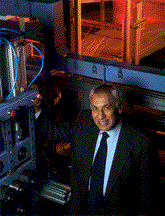
| Index |
| Introduction |
| Early History |
| Deans and Faculty |
| Recent History |
| Credits |
| Exhibits |
| Special Collections |
| NC State University Libraries |
Recent History
 |
|
Nelson
Hall
|
The
college continued to expand and a new building (Nelson Hall) was dedicated March
3, 1940. In 1943 Malcolm E. "Sandy" Campbell succeeded Nelson as dean of the
textiles school, and expansion continued. The college joined in the defense
effort during World
War II by offering
a course in fabric inspection and testing for those employed in war industries.
In addition, faculty from the College of Textiles investigated substitutes for
silk, which was critically needed for the manufacture of parachutes. The college
was instrumental in North Carolina's production of fabric for the war, which
surpassed all other states.
 |
|
Professor
Ed Shinn (left) with Dean Campbell at the necktie machine where the artificial
aorta was developed.
|
After
the war the area of textiles research continued to broaden, and NC
State led the way. Research at the university led to Professor  William
"Ed" Shinn's 1955 development of the knitted OrlonTM aorta on a necktie machine.
In 1959 the state of North Carolina gave funds to support textiles research
for the first time. Campbell retired in 1967, and David Chaney was named the
new dean. Research funding grew, and the college received several large federal
grants during the 1970s. Dr. Solomon Hersh and a team of researchers at NC State
studied brown lung disease (byssinosis), a disease suffered by cotton mill workers.
Through their research they determined acceptable levels of exposure to cotton
dust and contributed to the establishment of occupational health standards in
textile mills.
William
"Ed" Shinn's 1955 development of the knitted OrlonTM aorta on a necktie machine.
In 1959 the state of North Carolina gave funds to support textiles research
for the first time. Campbell retired in 1967, and David Chaney was named the
new dean. Research funding grew, and the college received several large federal
grants during the 1970s. Dr. Solomon Hersh and a team of researchers at NC State
studied brown lung disease (byssinosis), a disease suffered by cotton mill workers.
Through their research they determined acceptable levels of exposure to cotton
dust and contributed to the establishment of occupational health standards in
textile mills.
Chaney retired in 1981, and Dame S. Hamby became the new dean of a textiles college that offered the largest textiles research program in the United States.
 |
|
Professor
Emeritus Mansour Mohamed
|
As the college planned the move to the university's new Centennial Campus, advances
in textiles research continued. Hamby retired and Robert A. Barnhardt became
dean in 1987. The next year groundbreaking for the new College of Textiles building
on Centennial campus was 17 May 1988. In the 100 years of textiles at NC State,
the college and the field of textiles has diversified. Professor
Emeritus Mansour Mohamed worked to produce a method of three-dimensional weaving
systems that produce lightweight, superstrong, high-performance textile composites
that are used in cars, planes, and in the aerospace industry. This technology
was developed for NASA's Mars Mission Research Center at NC State. In
the 1990s Dr. Sam Hudson found new uses for fiber made from chitin and chitosan,
materials extracted from the shells of crabs and other shellfish. He and others
at NC State have developed methods to use chitin and chitosan to clean wastewater
left by the dyeing process, to create fibers for paper-making, and to develop
a biodegradable wound dressing that employs chitosan's healing properties.
|
The
College of Textiles Complex at Centennial Campus
|
Tompkins, Ivey, and Nelson would all be astonished to see what textiles researchers, alumni, and students are doing in the dawn of the twenty-first century. Research on the Mars Mission, materials providing protection from hazardous chemicals, and collaboration with industry to produce innovative composite materials from tennis rackets to spacecraft are but a few of the exciting endeavors in which the college is involved.